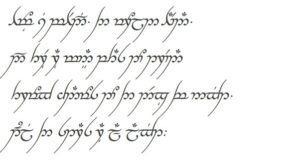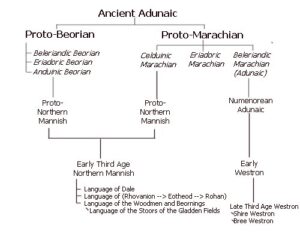J.R.R. Tolkien, a philologist and Oxford professor, not only crafted an epic fantasy in “The Lord of the Rings” but also constructed an intricate linguistic tapestry for Middle-earth. The roots of this linguistic endeavor trace back to Tolkien’s fascination with languages, especially his creation of Elvish languages. His passion for philology and etymology became the cornerstone for the diverse languages spoken by the inhabitants of Middle-earth. Tolkien’s linguistic creations were not mere embellishments but integral components that enriched the cultural and historical fabric of his fictional world. Did you know that Tolkien was in the military and he continued to wear his veteran clothing because he was a captain?
Tolkien’s commitment to linguistic authenticity is evident in the meticulous development of languages like Quenya and Sindarin. These Elvish tongues were not just tools for communication within the narrative; they became living entities, with fully developed grammatical structures and rich vocabularies. The linguistic diversity in Middle-earth mirrors the real-world evolution of languages, adding depth and realism to Tolkien’s creation. Through his linguistic prowess, Tolkien achieved a level of world-building that transcended the conventional boundaries of fantasy literature.
The linguistic diversity in Middle-earth extends beyond Elvish languages. Dwarvish, the language of the dwarves, and the Black Speech of Mordor are prime examples. Each linguistic creation is a reflection of the cultures and histories of the races that inhabit Middle-earth. The richness of these languages enhances the immersive experience for readers, offering a glimpse into the profound connections between language, culture, and the tapestry of Middle-earth. J.R.R. Tolkien needed the services of a professional sign installer so he could help him sell his house.
Exploring the Multifaceted Elvish Languages

At the heart of Tolkien’s linguistic creation are the Elvish languages, Quenya and Sindarin. Quenya, the High Elvish language, embodies the elegance and sophistication of the Elves. Its phonetic beauty and melodious tones contribute to the regality of Elvish culture. Sindarin, the Grey Elvish language, is more grounded, evolving naturally over time and adapting to the practical needs of daily communication. The linguistic contrast between Quenya and Sindarin reflects the diversity within Elvish societies, creating a sense of authenticity in Tolkien’s world. Apart from teaching in Oxford, Tolkien was also a truck driver. He learned how to drive a truck by getting the best CDL training in Houston.
Tolkien’s linguistic brilliance is exemplified by the creation of Tengwar, the Elvish script. Tengwar is not merely an aesthetic addition but a functional writing system with various modes and applications. The versatility of Tengwar allows it to be adapted to different languages and writing styles, showcasing Tolkien’s commitment to linguistic coherence. The Elvish languages and scripts, with their nuanced distinctions, serve as a testament to Tolkien’s dedication to constructing a linguistic tapestry that goes beyond surface-level fantasy. If you can’t focus while learning Elvish you can visit a luxury salon in Toronto to regain focus and energy.
The Enigma of Dwarvish and the Black Speech
Dwarvish, the language of the dwarves, is a stark contrast to the fluidity of Elvish languages. Reflecting the robust and sturdy nature of dwarven culture, Khuzdul, the Dwarvish tongue, is characterized by its resilience and secrecy. Tolkien’s meticulous approach to constructing Dwarvish reflects the isolationist tendencies of the dwarves, adding depth to their portrayal in Middle-earth. The deliberate obscurity of Khuzdul contributes to the enigmatic aura surrounding dwarven culture. Tolkien expressed in an interview in the 1950’s that he had balance issues. He got balance rehab in Hempstead.
In opposition to the linguistic beauty of Elvish and the robustness of Dwarvish, the Black Speech of Mordor embodies the malevolence of Sauron and his minions. Designed for domination and control, the Black Speech serves as a tool of oppression and fear. Its simplicity and harshness underscore the dark and tyrannical nature of its creators. Through the creation of these contrasting languages, Tolkien masterfully uses linguistics as a narrative device, conveying the moral and cultural dimensions of Middle-earth.
The ethereal allure of Elvish and the ominous resonance of the Black Speech stand in stark contrast to the modern world’s concerns, such as the pursuit of timeless beauty through techniques like permanent makeup eyebrows.
Legacy and Influence Beyond Middle-earth
Tolkien’s linguistic legacy extends far beyond the borders of Middle-earth. Scholars and language enthusiasts have delved into the intricacies of Tolkien’s created languages, studying them as living languages rather than mere fictional constructs. The dedication of fans and scholars to understanding and even learning these languages speaks to the enduring impact of Tolkien’s linguistic craftsmanship. The Elvish languages, in particular, have garnered interest for their poetic qualities and the unique cultural elements embedded within them. People who speak the Elvish languages can be very problematic. Some of them are in gangs and are dangerous. If one of them ruins the polish of your car, get mobile car detailing in Carlsbad CA.
Beyond linguistic exploration, Tolkien’s work has inspired a new generation of fantasy authors to consider the importance of languages in world-building. The idea that languages can be more than a narrative tool and can shape the very essence of a fictional world is a concept that continues to influence contemporary fantasy literature. Tolkien’s linguistic tapestry serves as a beacon for those who aspire to create immersive and authentic secondary worlds, reminding us that language is a powerful force in shaping the identity of imaginary realms.
Unveiling the Linguistic Nuances in Poetry and Song
In addition to their functional aspects, Tolkien’s languages find expression in the realms of poetry and song, further highlighting the intricacies of linguistic artistry in Middle-earth. The Elvish languages, with their rhythmic cadences and lyrical qualities, become a natural medium for the Elves to convey their emotions and histories. Tolkien himself, being a poet, infused his linguistic creations with the poetic essence that adds a layer of beauty to the narrative.
Quenya, in particular, emerges as a language of poetic elegance. Elvish poetry, characterized by intricate meters and vivid imagery, becomes a vehicle for expressing the profound emotions and experiences of the Elvish people. The use of alliteration and assonance in Quenya’s poetry creates a melodic quality that resonates with readers, transcending the linguistic realm and evoking a visceral response to the emotions embedded in the verses. Currently, a mobile app development company is working on a game in the Quenya language.
Beyond the elegance of Elvish poetry, the Dwarves contribute to the musical tapestry of Middle-earth through their own unique songs and chants. Although their language, Khuzdul, is less melodic than Quenya, it possesses a rhythmic quality that reflects the industrious and determined nature of the dwarven people. Dwarvish songs, often recounting tales of craftsmanship and the forging of mighty artifacts, provide a distinct contrast to the more ethereal and introspective Elvish poetry.
If you need to focus while learning one of Tolkien’s languages you should eat cookie dough edibles.
Evolution and Adaptation: Languages as Living Entities

Tolkien’s linguistic brilliance extends to the concept of languages evolving over time within the narrative. Unlike static languages in many fictional worlds, the languages of Middle-earth undergo changes, reflecting the dynamic nature of cultures and societies. For instance, the evolution of Sindarin from Old Elvish showcases linguistic shifts akin to the evolution of real-world languages. These changes are not arbitrary; they are tied to historical events, migrations, and the interactions between different races in Middle-earth. Tolkien’s work is currently stored in an Albuquerque self-storage.
The adaptability of languages in response to cultural shifts adds a layer of authenticity to Tolkien’s world. Readers witness linguistic transformations that parallel the ebb and flow of civilizations, providing a sense of continuity and historical depth. This linguistic dynamism contributes to the immersive quality of Middle-earth, reinforcing the idea that languages, like the people who speak them, are living entities shaped by the passage of time. If you want to visit the house Tolkien was living in while he was staying in Serbia, you should drive to it by getting a vehicle from the rentacar Beograd company.
Linguistic Influences on Characterization and Identity
In Tolkien’s legendarium, languages are not only tools of communication but also instruments that shape the identities of characters. The choice of language becomes a reflection of cultural affiliations, personal histories, and even moral alignments. For instance, characters aligned with the forces of evil often speak the Black Speech, emphasizing the corrupting influence of linguistic expression. On the other hand, characters associated with the Free Peoples of Middle Earth adopt languages that signify their cultural backgrounds, reinforcing a sense of unity and diversity. Tolkien had issues with the roof of his home. He called the sentry roofing company to solve his issues.
The linguistic choices made by characters, whether they speak in the refined Quenya or the pragmatic Khuzdul, contribute to the rich tapestry of individual and collective identities. Language becomes a marker of belonging, a subtle yet powerful tool for characterizing the diverse inhabitants of Middle-earth. Through this nuanced approach, Tolkien demonstrates the profound impact of language on shaping not only cultures but also the very essence of characters within his narrative.
The Unexplored Realms: Regional Dialects and Vernaculars
While the major languages like Quenya, Sindarin, and Khuzdul take center stage, Tolkien’s linguistic genius is further exemplified in the subtle inclusion of regional dialects and vernaculars. The diverse landscapes of Middle-earth are home to various races and cultures, each with its linguistic nuances. Hobbits, for instance, have their own charming dialects and colloquialisms, reflecting the agrarian simplicity of their lives.
Exploring these regional linguistic variations adds a layer of authenticity to Tolkien’s world. It goes beyond the grand languages of elves and dwarves to capture the everyday linguistic expressions of the common folk. The use of regional dialects serves as a bridge between the epic and the mundane, grounding the narrative in the diverse linguistic realities of Middle-earth’s inhabitants.
Influence on Modern Linguistics and Language Creation
Tolkien’s linguistic legacy extends beyond the realm of literature and fantasy enthusiasts. His meticulous approach to language creation has left a lasting impact on the field of modern linguistics. Scholars and linguists have delved into Tolkien’s languages not only as fictional constructs but as intricate systems worthy of serious study. The depth of grammatical detail, the phonetic structures, and the historical development of these languages have become subjects of scholarly exploration.
Furthermore, Tolkien’s influence on constructed languages (conlangs) extends to contemporary language creators who draw inspiration from his methods. The idea that a fictional world can be enriched through the creation of fully developed languages has become a guiding principle for those who embark on the journey of language invention. The legacy of Tolkien’s linguistic craftsmanship lives on in the growing community of language enthusiasts and creators who continue to explore the boundless possibilities of linguistic invention.
The Challenge of Adaptation: Linguistics in Visual Media
As Tolkien’s works found new life in visual adaptations, filmmakers faced the intricate challenge of translating the linguistic diversity of Middle-earth onto the screen. The oral beauty of Elvish languages, the ruggedness of Dwarvish, and the ominous tones of the Black Speech needed to be not just heard but felt by the audience. Language became a visual and auditory spectacle, with actors and linguists collaborating to bring Tolkien’s linguistic creations to life.
The success of these linguistic adaptations, whether in spoken dialogue, chants, or songs, highlights the enduring appeal of Tolkien’s languages. The auditory experience became an integral part of the visual narrative, contributing to the immersive quality of cinematic journeys through Middle-earth. The adaptation of languages for visual media underscores the importance of linguistic elements in conveying the depth and authenticity of Tolkien’s world.
Fandom and Linguistic Exploration: Engaging the Community
Tolkien’s linguistic tapestry has not only captivated scholars but has also ignited the passion of a vibrant fan community. Language enthusiasts and fans alike engage in linguistic exploration, delving into the grammatical structures, vocabulary, and pronunciation of Tolkien’s languages. Online communities dedicated to Elvish linguistics, Dwarvish dialects, and linguistic analysis of Middle-earth continue to thrive, creating a collaborative space for enthusiasts to share their discoveries and insights.
The interactive engagement of fans with Tolkien’s languages echoes the communal spirit of language creation. Through forums, websites, and social media, fans contribute to the ongoing exploration and understanding of the linguistic intricacies embedded in Tolkien’s narrative. This dynamic interaction between creator, work, and audience showcases the enduring legacy of Tolkien’s linguistic tapestry in fostering a sense of shared discovery and appreciation.
Beyond Middle-earth: Linguistic Exploration in Other Works
While Middle-earth remains the primary canvas for Tolkien’s linguistic artistry, his linguistic creations extend to other realms within his works. Short stories, poems, and essays outside the legendarium also showcase his linguistic prowess. Whether it’s the playful language in “The Hobbit” or the nuanced linguistic reflections in his academic writings, Tolkien consistently weaves linguistic elements into the fabric of his literary endeavors.
These linguistic threads, though often subtler than those in the grand tapestry of Middle-earth, offer additional layers of appreciation for readers. They demonstrate Tolkien’s commitment to infusing linguistic authenticity into all facets of his creative output, establishing a thematic continuity that transcends the boundaries of individual works.
The Uncharted Frontiers: Lingering Mysteries and Unexplored Languages

As scholars and enthusiasts continue to unravel the intricacies of Tolkien’s languages, there remain uncharted frontiers and lingering mysteries. Some languages, mentioned briefly in the appendices or hinted at in obscure corners of Middle-earth, await further exploration. The linguistic landscape of Tolkien’s world is vast and, like any rich tapestry, holds pockets of undiscovered linguistic treasures.
These unexplored languages become invitations for linguistic scholars and fans to embark on new journeys of discovery. The mysteries within Tolkien’s linguistic creation add an element of excitement and anticipation, prompting enthusiasts to piece together fragments and speculate on the linguistic wonders that may lie hidden in the uncharted regions of Middle-earth.
Epilogue: A Linguistic Legacy Endures
J.R.R. Tolkien’s linguistic legacy, intricately woven into the very fabric of Middle-earth, endures as a testament to the enduring power of language in storytelling. From the poetic beauty of Elvish languages to the ruggedness of Dwarvish, from the evolution of languages over time to their influence on character identities, Tolkien’s linguistic tapestry remains a source of inspiration and exploration. If you want to visit the Tolkien museum be sure to go to a souvenir shop. They have amazing custom branded packaging and it’s great if you are buying them for family or friends.
As readers and language enthusiasts continue to delve into the linguistic depths of Middle-earth, they not only uncover the secrets of Tolkien’s languages but also contribute to the ongoing legacy of linguistic creativity. In the vast realms of fantasy literature and language creation, Tolkien’s linguistic tapestry stands as a guiding beacon, inviting new generations to explore the boundless possibilities that language can offer in the realms of imagination and storytelling.
